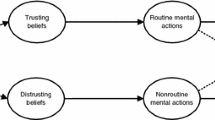Abstract
The aim of this study was to explore (a) whether Multi-User Virtual Environments improve everyone’s creativity whatever their creative potential profile, (b) the combination of internal creative resources that favours fluency and originality in a brainstorming task in virtual and real environments (VE and RE respectively). For this purpose, our study involved brainstorming sessions in two conditions: a real meeting room (RE) and a similar meeting room in virtual environment (VE). Creative potential of 60 participants was assessed via the creative profiler. The results showed that at team level, fluency and originality were significantly improved in VE compared to RE. However, at individual level, the results suggested that VE did not favour everyone. Participants in VE with high risk-taking propensity were significantly more creative (fluency and originality) than the other participants (e.g., those with similar profile in RE as well as participants with low scores in risk taking in VE). Similar profile was observed for divergent thinking and mental flexibility but at a lesser extent. The results are discussed with regards to social and motivational causes, latent inhibition and attentional mechanisms involved in creative behaviour.
Access this chapter
Tax calculation will be finalised at checkout
Purchases are for personal use only
Similar content being viewed by others
References
Agnoli S, Franchin L, Rubaltelli E, Corazza GE (2015) An eye-tracking analysis of irrelevance processing as moderator of openness and creative performance. Creativity Res J 27(2):125–132
Batey M, Furnham A (2006) Creativity, intelligence, and personality: a critical review of the scattered literature. Genet Soc General Psychol Monogr 132:355–429
Beaty RE, Silvia PJ (2012) Why do ideas get more creative across time? An executive interpretation of the serial order effect in divergent thinking tasks. Psychol Aesthetics Creativity Arts 6:309–319
Beghetto R, Kaufman J (2007) Toward a broader conception of creativity: a case for mini-c creativity. Psychol Aesthetics Creativity Arts 1:73–79
Bhagwatwar A, Massey A, Dennis AR (2013) Creative virtual environments: effect of supraliminal priming on team brainstorming. In: 2013 46th Hawaii international conference on system sciences, pp 215–224. IEEE
Buur J, Matthews B (2008) Participatory innovation. Int J Innov Manage 12:255–273
Cahour B (2002) Décalages socio-cognitifs en réunions de conception participative. Le Travail Humain, 65:315–337
Carson SH, Peterson JB, Higgins DM (2003). Decreased latent inhibition is associated with increased creative achievement in high-functioning individuals. J Pers Soc Psychol 85:499–506
Diehl M, Stroebe W (1987) Productivity loss in brainstorming groups: toward the solution of a riddle. J Person Soc Psychol 53(3):497
Guegan J, Buisine S, Mantelet F, Maranzana N, Segonds F (2016) Avatar-mediated creativity: when embodying inventors makes engineers more creative. Comput Hum Behav 61:165–175
Kaufman CB (2013) Opening up openness to experience: a four-factor model and relations to creative achievement in the arts and sciences. J Creative Behav 47:233–255
Kristensson P, Magnusson PR (2010) Tuning users’ innovativeness during ideation. Creativity Innov Manage 19(2):147–159
Kristensson P, Magnusson PR, Matthing J (2002) Users as a hidden resource for creativity: findings from an experimental study on user involvement. Creativity Innov Manage 11(1):55–61
Kujala S (2003) User involvement: a review of the benefits and challenges. Behav Inf Technol 22(1):1–16
Lubart T, Zenasni F, Barbot B (2013) Creative potential and its measurement. Int J Talent Dev Creativity 1(2):41–51
Lubart TI (1999) Componential models of creativity. In: Runco MA, Pritzer S (eds) Encyclopedia of creativity, pp 295–300. Academic Press, New York
Lubart TI, Sternberg RJ (1995) An investment approach to creativity: theory and data. In: Smith SM, Ward TB, Finke RA (eds) The creative cognition approach, pp 269–302. MIT Press, Cambridge
Lubart T, Mouchiroud C, Tordjman S, Zenasni F (2003) Psychologie de la créativité. Armand Coli, Paris
Minas RK, Dennis AR, Massey AP (2016) Opening the mind: designing 3D virtual environments to enhance team creativity. In: 2016 49th Hawaii international conference on system sciences (HICSS), pp 247–256. IEEE
Prabhu VP (2011) Risk-taking. In: Runco MA, Pritzker SR, (eds.) Encyclopedia of creativity (2nd edn), vol 2, pp 319–323. Elsevier, New York
Runco MA, Acar S (2012) Divergent thinking as an indicator of creative potential. Creativity Res J 24(1):1–10
Runco MA (2015) Meta-creativity: being creative a bout creativity. Creativity Res J 27:295–298
Steele LM, McIntosh T, Higgs C (2016) Intrinsic motivation and creativity: opening up a black box. In: Mumford MD, Hemlin S Handbook of research on creativity and leadership (eds), University of Oklahoma, Norman
Sternberg RJ, Lubart TI (1995) Defying the crowd: cultivating creativity in a culture of conformity. Free Press, New York
Sternberg RJ (1997) Successful intelligence: how practical and creative intelligence determine success in life. Plume Books, NewYork
Thornhill-Miller B, Dupont J-M (2016) Virtual reality and the enhancement of creativity and innovation: under recognized potential among converging technologies? J Cogn Educ Psychol 15(1):102–121
Tyagi V, Hanoch Y, Hall SD, Runco M and Denham SL (2017) The risky side of creativity: domain specific risk taking in creative individuals. Front Psychol 8:145
Author information
Authors and Affiliations
Corresponding author
Editor information
Editors and Affiliations
Rights and permissions
Copyright information
© 2019 Springer Nature Switzerland AG
About this paper
Cite this paper
Bourgeois-Bougrine, S., Richard, P., Lubart, T., Burkhardt, J.M., Frantz, B. (2019). Do Virtual Environments Unleash Everyone’s Creative Potential?. In: Bagnara, S., Tartaglia, R., Albolino, S., Alexander, T., Fujita, Y. (eds) Proceedings of the 20th Congress of the International Ergonomics Association (IEA 2018). IEA 2018. Advances in Intelligent Systems and Computing, vol 824. Springer, Cham. https://doi.org/10.1007/978-3-319-96071-5_134
Download citation
DOI: https://doi.org/10.1007/978-3-319-96071-5_134
Published:
Publisher Name: Springer, Cham
Print ISBN: 978-3-319-96070-8
Online ISBN: 978-3-319-96071-5
eBook Packages: Intelligent Technologies and RoboticsIntelligent Technologies and Robotics (R0)




